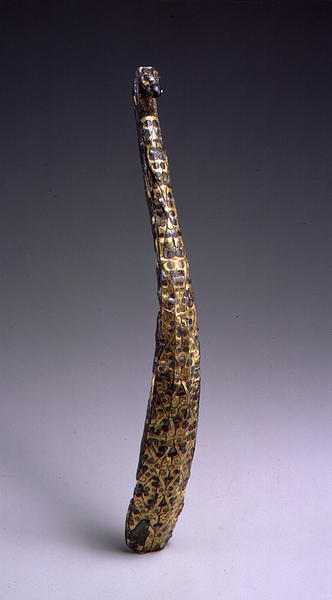帯鉤
- 中国
- 中国・東周時代
- 前4世紀
- 鉄、金、銀
- H-25.2
豪華に装飾された帯鉤は、前千年紀後半において上流階級の男性が身につける装身具の中で最も重要なものであった。こうした帯鉤は世俗的な品物で、地位と富のある人の、贅沢を好む気持ちとそれを他人に誇示したいという願望を反映しており、宗教的ないし儀礼的な意味をもつものではなかった。本作品の如き鉄の帯鉤は高温で焼成された陶製の鋳型で鋳造されており、恐らく青銅よりも安価な新製品と考えられたとみられ、磨くと白い表面に光沢が生じ、それは付加された金ないし銀との間に美しい対照効果を生んだ。鉤の部分は動物の頭の形に鋳造され、リュート形の胴部は平らな三面の面取りが施された断面をもっている。この形は前4世紀および3世紀の間に人気を博するようになった
Catalogue Entry
Lavishly embellished belt hooks were the most important objects of personal adornment worn by the elite male during the latter half of the first millennium B.C. Such hooks were secular objects, reflecting a love of display and luxury expected of a person of status and wealth, and had no religious or ritual significance.
Iron hooks, like this example, were cast in high-fired ceramic molds and were probably considered a novelty, cheaper than bronze, and, when polished, the shiny white surfaces contrasted well with the further addition of gold and silver. The hook itself is cast in the shape of an animal head, and the lute-shaped body is triplanar in cross-section, a shape that became popular during the late fourth and third centuries B.C.1 The body of the belt hook has been inlaid with thin gold foil to produce an overall symmetrical design forming lozenges, triangles, and spirals. The resulting lattice has been further embellished by silver foil inlays. The reverse, which is partly corroded, is set with a stud for attachment to a belt.
Iron belt hooks decorated with foil have been found at sites in Shanxi, such as Qiaocun, Houma.2 Microscopic examination has shown that the iron was cast with space reserved for the gold and silver inlays. These reserves as well as channels cut to better hold the inlays can be observed where the inlays are missing. The black seen in-between the inlays is polished iron.
ECB
1. White and Bunker 1994, p. 99, no. 20.
2. Wagner 1993, p. 171, fig. 4.16.1; cat. no. 89 above.
